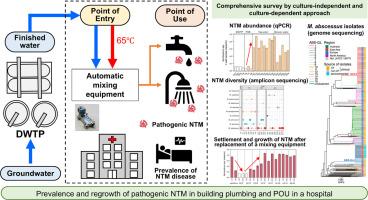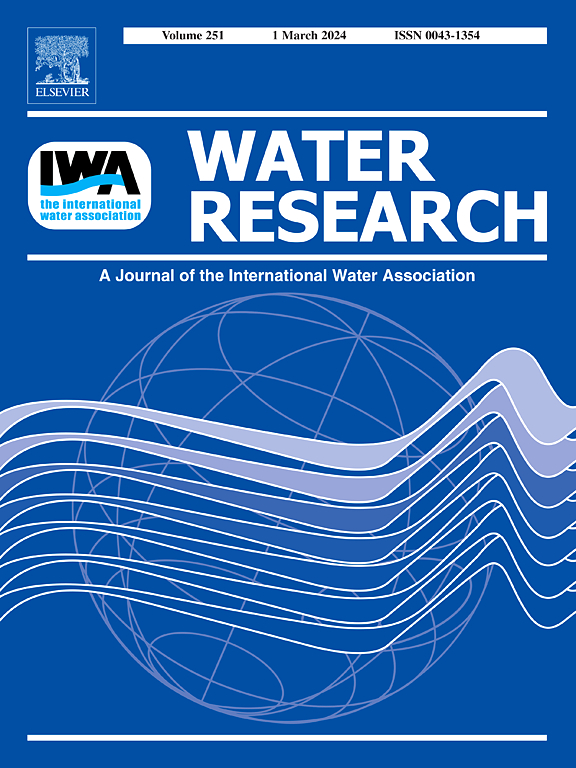Unveiling Significant Regrowth and Potential Risk of Nontuberculous Mycobacteria in Hospital Water Supply System
IF 11.4
1区 环境科学与生态学
Q1 ENGINEERING, ENVIRONMENTAL
引用次数: 0
Abstract
The health burden of waterborne nontuberculous mycobacteria (NTM) is a rising concern. While the water supply systems can serve as a potential reservoir for NTM, their abundance, diversity, and transmission pathways remain unknown. This study aimed to characterize the prevalence and regrowth of NTM in building water supply system in a hospital where many M. abscessus were isolated from patients. The depletion of residual chlorine after stagnation and supply of warm water at the point of use promoted significant microbial regrowth, including NTM, in the hospital. The absolute abundance of Mycobacterium spp. 16S rRNA genes in tap water and shower water samples increased to approximately 104 copies/mL, while it was below the quantification limit in the finished water from a drinking water treatment plant. Amplicon sequencing of NTM-specific hsp65 genes revealed that M. abscessus was prevalent in all samples, while the dominant NTM species varied depending on locations even in the same building. The presence of M. abscessus in water suggested the possibility of waterborne transmission in the hospital. M. abscessus was frequently isolated from tap water, shower water, and shower biofilms. These isolates demonstrated high clonality and were closely affiliated with the ABS-GL4 cluster of M. abscessus subsp. abscessus. Even though the automatic mixing equipment at the point of use was replaced with new one, the settlement and growth of NTM were reproducibly observed, suggesting mixing equipment as a hotspot for NTM proliferation. Additional interventions including water quality control are required as the hospital water supply system is a hot spot for NTM regrowth.

揭示医院供水系统中非结核分枝杆菌的显著再生及潜在风险
水源性非结核分枝杆菌(NTM)的健康负担日益受到关注。虽然供水系统可以作为NTM的潜在蓄水池,但它们的丰度、多样性和传播途径仍然未知。本研究旨在了解某医院建筑供水系统中NTM的流行和再生情况,该医院从患者身上分离出许多脓肿分枝杆菌。停滞后剩余氯的消耗和在使用点提供温水促进了医院内微生物的显著再生,包括NTM。自来水和淋浴水样中分枝杆菌16S rRNA基因的绝对丰度增加到约104拷贝/mL,而在饮用水处理厂的成品水中则低于定量限制。NTM特异性hsp65基因扩增子测序显示,脓肿分枝杆菌在所有样本中普遍存在,而NTM的优势种即使在同一建筑物中也因位置而异。水中发现脓肿支原体,提示有可能在医院发生水媒传播。脓肿分枝杆菌常从自来水、淋浴水和淋浴生物膜中分离出来。这些分离株具有较高的克隆性,与脓疡分枝杆菌亚种的ABS-GL4群密切相关。脓肿。尽管更换了使用点的自动搅拌设备,但仍可再现地观察到NTM的沉降和生长,说明搅拌设备是NTM增殖的热点。由于医院供水系统是NTM再生的热点,因此需要采取包括水质控制在内的额外干预措施。
本文章由计算机程序翻译,如有差异,请以英文原文为准。
求助全文
约1分钟内获得全文
求助全文
来源期刊

Water Research
环境科学-工程:环境
CiteScore
20.80
自引率
9.40%
发文量
1307
审稿时长
38 days
期刊介绍:
Water Research, along with its open access companion journal Water Research X, serves as a platform for publishing original research papers covering various aspects of the science and technology related to the anthropogenic water cycle, water quality, and its management worldwide. The audience targeted by the journal comprises biologists, chemical engineers, chemists, civil engineers, environmental engineers, limnologists, and microbiologists. The scope of the journal include:
•Treatment processes for water and wastewaters (municipal, agricultural, industrial, and on-site treatment), including resource recovery and residuals management;
•Urban hydrology including sewer systems, stormwater management, and green infrastructure;
•Drinking water treatment and distribution;
•Potable and non-potable water reuse;
•Sanitation, public health, and risk assessment;
•Anaerobic digestion, solid and hazardous waste management, including source characterization and the effects and control of leachates and gaseous emissions;
•Contaminants (chemical, microbial, anthropogenic particles such as nanoparticles or microplastics) and related water quality sensing, monitoring, fate, and assessment;
•Anthropogenic impacts on inland, tidal, coastal and urban waters, focusing on surface and ground waters, and point and non-point sources of pollution;
•Environmental restoration, linked to surface water, groundwater and groundwater remediation;
•Analysis of the interfaces between sediments and water, and between water and atmosphere, focusing specifically on anthropogenic impacts;
•Mathematical modelling, systems analysis, machine learning, and beneficial use of big data related to the anthropogenic water cycle;
•Socio-economic, policy, and regulations studies.
 求助内容:
求助内容: 应助结果提醒方式:
应助结果提醒方式:


